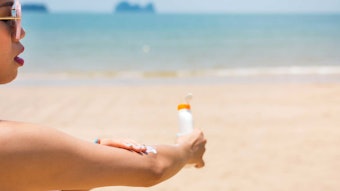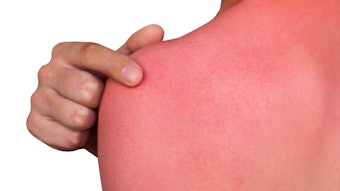
The UK and EU have defined how sunscreens are made, marketed and labeled, as well as established new ISO test methods. This update highlights key developments in SPF testing, and UVA protection and compliance standards for sun care across Europe.
This article is only available to registered users.
Log In to View the Full Article
The UK and EU have defined how sunscreens are made, marketed and labeled, as well as established new ISO test methods. This update highlights key developments in SPF testing, and UVA protection and compliance standards for sun care across Europe.
Sun protection is a subject very close to my heart. This is not just because my skin type burns easily, but because the subject of my PhD involved recreating the skin pigment melanin in the laboratory and trying to investigate the pathway of malignant melanomas caused by the damaging effects of the sun.
Our understanding of and attitude toward the sun and its effects have changed significantly over the years.
- We have moved from "suntan lotions" to "sun protection" products."
- We now know the different types of rays that comprise the UV spectrum and have developed filters to cover the relevant wavelengths.
- Formulations have become more sophisticated and diverse to encourage compliance even at higher SPF levels.
- In addition, just as we now appreciate both the drawbacks and the benefits of sun exposure, we are also aware of the importance of sunscreens as part of a sun-safe regime while acknowledging some of their shortcomings — such as consumer confusion over sunscreen labeling.
The perspectives I am about to share come from the UK and EU viewpoints. In certain jurisdictions, not least the U.S. and Australia, sunscreens are not regulated under cosmetics legislation but I hope the information below will be of interest to anyone marketing sunscreens across Europe.
Sunscreens as Cosmetics
In the UK and EU, sunscreens are classified as cosmetic products and all such products placed on the UK and EU markets are covered by the UK and EU Cosmetics Regulations, respectively: the UK Cosmetics Regulation1 and EU Cosmetics Products Regulation (1223/2009).2
When the UK left the EU, many sectorial legislations required the retention of EU legislation into the UK. This was the case for the cosmetics legislation. Therefore, the UK Cosmetics Regulation (UKCR) is very similar to the EU Cosmetic Products Regulation (CPR).
Both the UKCR and CPR stipulate requirements for manufacturing, labeling, ingredients and the safety assessment of cosmetic products, and the main aim of the regulations are consumer safety. Each cosmetic product must undergo an assessment by a qualified and experienced assessor (whose qualifications are stated in the UKCR/CPR) before it is made available for sale. The safety assessment takes into account of all the ingredients used in the product and how the product will be used, by whom, where and how often.
The UKCR and CPR also control what may or may not be put into a cosmetic product. The regulations include lists of substances that must not be present, or those that may be used under particular restrictions.
In addition, certain classes of ingredients (colors, UV filters and preservatives) are on positive lists — so only pre-approved individual ingredients listed in the UKCR/CPR are allowed for cosmetic purposes. Notably, sunscreens in the UK may use the same UV filters that are allowed in the EU.
Sunscreen Efficacy and Labeling
All product advertising must be legal, decent, honest and truthful and must not mislead the consumer. In addition to general advertising rules, under UK and EU cosmetics law, any claim made by a product must be substantiated, which includes an SPF number, protection category or UVA protection.
Cosmetics claims require robust evidence, and that it be made available for scrutiny by the regulating authority. Article 20 of the UK and EU Cosmetics Regulations state the provisions for cosmetic claims. In addition, cosmetic claims in both the UK and the EU must comply with EU Regulation 655/2013 providing the Common Criteria for Cosmetic Claims.
While the UK and EU Cosmetics Regulations do not specify which tests must be carried out to substantiate any particular claim, for sun protection claims on the UK and EU markets, it is currently industry best practice to use International Organization for Standardization (ISO) test methods.
- For SPF, the ISO in vivo SPF Test Method (24444)3 is used and
- The UVA in vitro Test Method (24443)4 is used to determine UVA protection.
It is, of course, important that manufacturers of sunscreens do not rely on just one measurement to determine sun protection. Companies must build up a weight of evidence to support the on-pack sun protection claims, ensuring that the dossier of data compiled, from R&D through production to final product, supports the final SPF and UVA protection labeled on-pack.
These testing regimes by manufacturers must be taken into account if any ad-hoc testing of a product is to be carried out, or any challenge of an on-pack claim is made.
EU Commission Recommendation on Sunscreen Efficacy and Claims
In 2006, the European Commission issued a recommendation5 on the efficacy of sunscreen products and their claims. It suggests that consumers choose a product that provides both UVA and UVB protection. It also lists the SPF numbers that may be used alongside an indication of the type of protection the sunscreen offers; i.e., low, medium, high or very high.
Concerning UVA protection, this will be evident on the sunscreen label. In the UK and across the EU, UVA protection is indicated on-pack by showing the letters UVA in a circle. This logo is used throughout Europe to show that a product contains at least the recommended minimum level of UVA protection for a sunscreen — at least one third of the SPF. This level is also noted in the commission recommendation.
The commission and a working group of some Member States and industry organizations, including Cosmetics Europe (the European personal care association), are currently looking at updating the 2006 recommendation, with the aim of further simplifying the SPF numbers and labeling.
New ISO SPF Testing Methods
The 2006 EU Commission Recommendation5 notes the use of certain test methods in order to ensure reproducibility and comparability of the recommended minimum protection against UVB radiation.
However, it also states that while these testing methods should be used as reference methods, preference should be given to in vitro testing methods delivering equivalent results, as in vivo methods raise ethical concerns. It adds that industry should increase efforts to develop in vitro testing methods for the protection against both UVB and UVA radiation.
The ISO in vivo SPF Test Method (24444)3 has been used for many years and to date, it has been viewed as the gold standard. But notably, is a test conducted by humans on humans.
While an ISO in vitro method4 for the measurement of UVA protection has been published since 2012, a reliable, repeatable and reproducible in vitro test method to measure SPF has proved difficult despite intense activity to develop such a standard.
Then in December 2024, ISO published two new methods for measuring the SPF of cosmetic products. One method developed by Cosmetics Europe expert members is in vitro, the Double Plate Method (ISO 23675:2024),6 and does not require human volunteers.
The other is a hybrid method, Hybrid Diffuse Reflectance Spectroscopy (HDRS) (ISO 23698:2024),7 which provides a noninvasive optical assessment of the protection provided by sunscreen on human skin without requiring a physiological skin response.
ISO 23675:2024 in vitro determination of SPF: In terms of the in vitro or Double Plate Method (DPM):
- As stated, it does does not require human volunteers to measure SPF, which makes it the only fully in vitro SPF method currently available. It provides reliable, repeatable and reproducible results.
- It is applicable to sunscreen products in the form of an emulsion or alcoholic, one-phase formulation but not those in loose or compressed powder or stick forms.
- It also is not applicable for the determination of the water resistance properties of a sun protection product.
ISO 23698:2024 measurement of sunscreen efficacy by diffuse reflectance spectroscopy: In terms of the hybrid HDRS method:
- It can characterize the SPF, UVA protection factor and critical wavelength protection of sunscreen products without requiring biological responses.
- It is applicable for emulsions and single-phase products but has not been evaluated for use with powder form sunscreen products.
- And it gives specifications to enable determination of the absolute spectral absorbance characteristics of a sunscreen product on skin to estimate sunburn and UVA protection.
It is anticipated that companies will, over time, move to using one of these new methods to measure SPF protection. Importantly, if a formulation has already been tested using the in vivo SPF Test Method (24444),3 it does not need to be retested using either of the new SPF ISO methods.6, 7
Also note that the new alternative SPF ISO test methods and the current in vivo (24444) method are not like-for-like, and neither the test methods nor their results should be directly compared with each other.
In addition, and as previously mentioned, a weight of evidence will still be required to support on-pack sun protection claims and should not rely just on one measurement. Therefore, companies should use the most suitable method for their formulations and continue to build up and document a dossier of data that supports the end SPF and UVA on-pack protection.
Cosmetics Europe Recommendations on Testing
In 2022, Cosmetics Europe issued a recommendation when the two alternative methods to the in vivo SPF ISO Test Method (24444)3 were reaching the final stages of the ISO process.
In addition, with the publication of the final methods ISO 23675:20246 and ISO 23698:2024,7 Cosmetics Europe updated its Recommendation No. 26 On the Use of Alternative Methods to ISO 24444:2019.8
The updated recommendation:
- Introduces the two new SPF test methods and
- Offers some guidance on their use and application.
Conclusion
It is good news to see a positive outcome from the many years of work — on a global level — to establish two new SPF testing standards as alternatives to the in vivo SPF Test Method.
References
1. Office of Product Safety and Standards. (2020). The Product Safety and Metrology etc. (Amendment etc.) (EU Exit) Regulations 2019 – Schedule 34. Available at: https://www.legislation.gov.uk/eur/2009/1223/contents
2. Official Journal of the European Union. (2009). Regulation (EC) No. 1223/2009 of the European Parliament and of the Council of 30 November 2009 on cosmetic products. Available at: https://eur-lex.europa.eu/legal-content/EN/TXT/?uri=CELEX%3A02009R1223-20221217#tocId26
3. International Organization for Standardization. (2019). ISO 24444:2019 Cosmetics - Sun protection test methods - In vivo determination of the sun protection factor (SPF). Available at: https://www.iso.org/standard/72250.html
4. International Organization for Standardization. (2021). ISO 24443:2021 Cosmetics - Determination of sunscreen UVA photoprotection in vitro. Available at: https://www.iso.org/standard/75059.html
5. Official Journal of the European Union. (2006). Commission Recommendation of 22 September 2006 on the efficacy of sunscreen products and the claims made relating thereto. Available at: https://eur-lex.europa.eu/eli/reco/2006/647/oj/eng
6. International Organization for Standardization. (2024). ISO 23675:2024 Cosmetics - Sun protection test methods - In vitro determination of sun protection factor (SPF). Available at: https://www.iso.org/standard/76616.html
7. International Organization for Standardization. (2024). ISO 23698:2024 Cosmetics - Measurement of the sunscreen efficacy by diffuse reflectance spectroscopy. Available at: https://www.iso.org/standard/76699.html
8. Cosmetics Europe. (2025). Cosmetics Europe Recommendation N° 26 On the Use of Alternative Methods to ISO24444:2019. Available at: https://cosmeticseurope.eu/wp-content/uploads/2024/10/23.06.2025_COSMETICS-EUROPE-RECOMMENDATION-N%C2%B0-26-1.pdf



!['[Sunscreen] developers will be able to innovate more efficiently while maintaining high standards of quality and safety for consumers.'](https://img.cosmeticsandtoiletries.com/files/base/allured/all/image/2024/06/woman_outside_using_sunscreen_on_face_ISO_test_standards_AdobeStock_783608310.66678a92029d9.png?auto=format%2Ccompress&fit=crop&h=191&q=70&rect=62%2C0%2C2135%2C1200&w=340)






